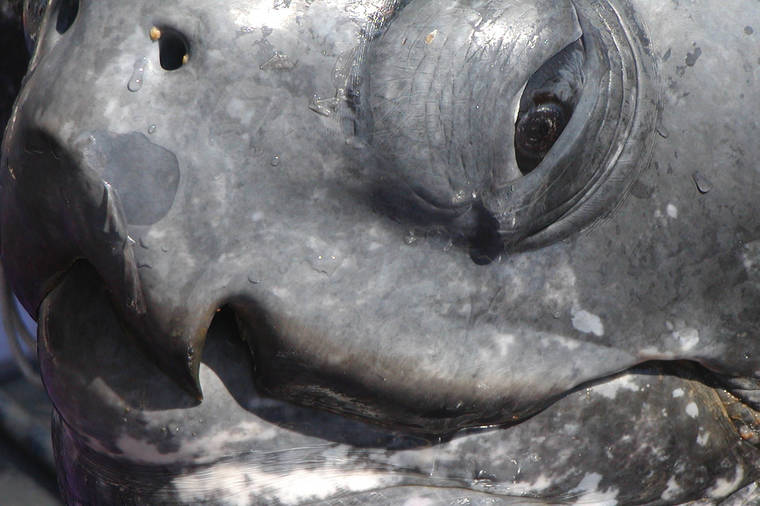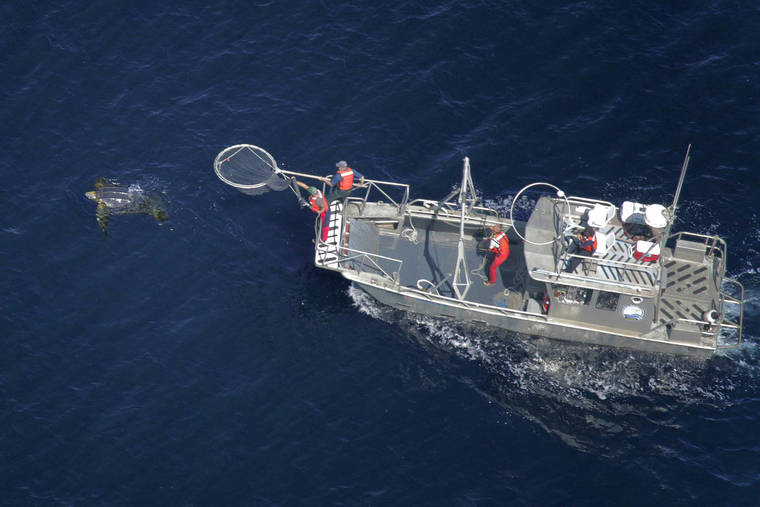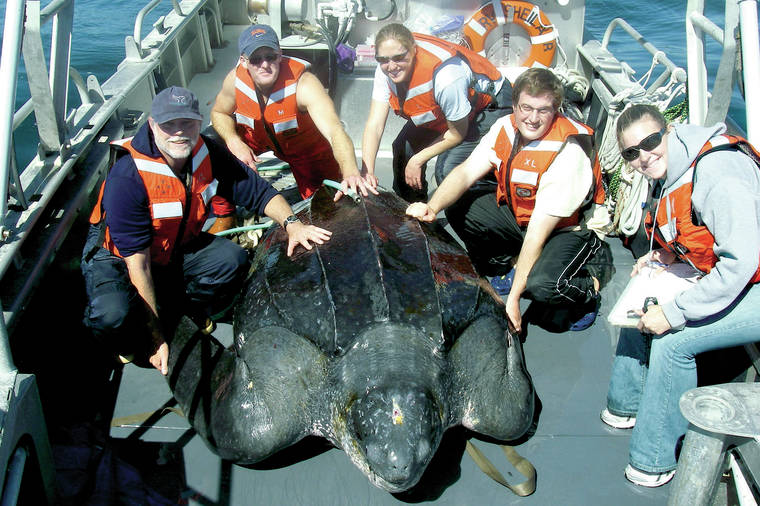ONLINE EXTRA: Steep decline in giant sea turtles seen off US West Coast

In this Sept. 10, 2002, photo provided by Scott Benson, a leatherback turtle is seen in Monterey, Calif., during a scientific expedition to research the turtles’ migration patterns. All seven distinct populations of leatherbacks in the world are troubled, but a new study shows an 80% population drop in just 30 years for one extraordinary sub-group that migrates 7,000 miles across the Pacific Ocean to feed on jellyfish in cold waters off California. Scientists say international fishing and the harvest of eggs from nesting beaches in the western Pacific are to blame. (Scott Benson via AP)

In this aerial photo provided by Joel Schumacher, scientists in a research boat pursue a Pacific leatherback turtle in the Pacific Ocean off California in September 2016. All seven distinct populations of leatherbacks in the world are troubled, but a new study shows an 80% population drop in just 30 years for one extraordinary sub-group that migrates 7,000 miles across the Pacific Ocean to feed on jellyfish in cold waters off California. Scientists say international fishing and the harvest of eggs from nesting beaches in the western Pacific are to blame. (Joel Schumacher via AP)

In this photo provided by Heather Harris, taken Sept. 25, 2007, in the waters off central California, scientists including Scott Benson, at far left, can be seen posing with a giant western Pacific leatherback sea turtle as they take measurements and attach a GOP satellite tracking device to its shell. All seven distinct populations of leatherbacks in the world are troubled, but a new study shows an 80% population drop in just 30 years for one extraordinary sub-group that migrates 7,000 miles across the Pacific Ocean to feed on jellyfish in cold waters off California. Scientists say international fishing and the harvest of eggs from nesting beaches in the western Pacific are to blame. (Heather Harris/NOAA-ESA Permit #15634 via AP)
MONTEREY, Calif. — Scientists were documenting stranded sea turtles on California’s beaches nearly 40 years ago when they noticed that leatherbacks — massive sea turtles that date to the time of the dinosaurs — were among those washing up on shore.
MONTEREY, Calif. — Scientists were documenting stranded sea turtles on California’s beaches nearly 40 years ago when they noticed that leatherbacks — massive sea turtles that date to the time of the dinosaurs — were among those washing up on shore.
It was strange because the nearest known population of the giants was several thousand miles away in the waters of Central and South America.
ADVERTISING
Their mysterious presence led researchers to a startling discovery. A subset of leatherbacks that hatches on beaches in Indonesia, Papua New Guinea, Vanuatu and the Solomon Islands were migrating 7,000 miles across the Pacific Ocean to the cold waters off the U.S. West Coast, where they gorged on jellyfish before swimming back. The epic journey stunned scientists.
“There are birds that go farther, but they fly. There’s a whale shark that might swim a little further, but it doesn’t have to come up for air. This animal is actually pushing water all the way across the Pacific Ocean,” said Scott Benson, an ecologist with the National Oceanic and Atmospheric Administration’s fisheries service in Monterey, who has studied the turtles for decades. “It’s just a majestic animal.”
But now, just as scientists are beginning to fully understand the amazing odyssey, the turtles are disappearing — and fast.
In less than 30 years, the number of western Pacific leatherbacks in the foraging population off of California plummeted 80% and a recent study co-authored by Benson shows a 5.6% annual decline — almost identical to the decline documented thousands of miles away on nesting beaches. About 1,400 adult females were counted on western Pacific nesting beaches, down from tens of thousands of turtles a few decades ago, and there are as few as 50 foraging off California, Benson said.
If nothing changes, scientists say, the leatherbacks — creatures that can weigh half as much as a compact car and have 4-foot-long flippers — could be gone from the U.S. West Coast within three decades, a demise brought on by indiscriminate international fishing, the decimation of nesting grounds and climate change.
“The turtles were there and we finally started paying attention,” said Jim Harvey, director of San Jose State University’s Moss Landing Marine Laboratories at San Jose State University and the study’s co-author. “We got into looking at the story just as the story was ending.”
The study provides critical, but devastating, new population information that doesn’t bode well for the leatherbacks, said Daniel Pauly, a fisheries professor at the University of British Columbia and an international expert on reducing commercial fishing’s impact on marine ecosystems.
“If you find the decline in one place, that might have a number of causes, but if you find the same estimate of decline in two places that indicates something much more serious,” said Pauly, who was not involved in the study. “They are really in big trouble.”
NOAA launched an aggressive initiative to save them in 2015 and will now release an updated action plan this month to inspire greater international cooperation in reducing the number of eggs pillaged on beaches and the number of Pacific leatherbacks entangled in commercial fishing gear.
“There is an opportunity right now to stop the decline, but we must seize that opportunity immediately and that will require an international effort by all the nations this animals interacts with,” said Benson. “If nothing is done to reverse this course, this population will become, essentially, extinct in the Pacific Ocean.”
The leatherbacks have likely been foraging off the U.S. West Coast for millennia. There are six other distinct leatherback populations scattered around the world but none of them complete such a long migration. As many as 60% of the leatherback turtles that hatch in the western Pacific Ocean make the trip to California — and scientists aren’t sure why some do and others don’t. Some go farther north, to waters off Oregon and even Washington state.
All the world’s leatherbacks are under pressure, but the subset that migrates for months across the vastness of the Pacific faces unique threats that are particularly difficult for conservationists to counter. Leatherbacks in the eastern Pacific, which nest in Mexico and Costa Rica, are also experiencing a population crash from a sharp reduction in nesting beaches.
In the water, commercial fishing boats pursue swordfish in an international no-man’s-land, where strict U.S. fishing laws don’t apply, and fishing nets and long lines intended for swordfish can injure or kill turtles. They must navigate the fishing grounds of Indonesia, Malaysia, Philippines and Japan and other nations to reach the U.S. West Coast.
On land, leatherback eggs on nesting beaches in the western Pacific are frequently wiped out by wild animals or humans, who collect the delicacies to eat or sell. Sand-mining operations and development on private beaches are also encroaching on leatherback nests.
In the U.S., swordfish fishing with long lines has been banned for 20 years from mid-August to mid-November to protect the giant turtles in a 186,000-square-mile (481,787-square-kilometer) zone off the West Coast. Most recently, California is phasing out the only small drift gill net fishery in the state by 2024, and the long-line swordfish fleet in Hawaii and California must shut down if they accidentally catch more than 16 leatherbacks fleet-wide in a season.
Last year, President Donald Trump vetoed a bill co-sponsored by U.S. Sen. Diane Feinstein, a California Democrat, that would have phased out a type of fishing with large mesh underwater nets known to ensnare sea turtles and other species. She reintroduced it in February.
These measures have been largely successful in driving down harm to Pacific leatherbacks off the U.S. West Coast and Hawaii. Between 1990 and 2000, 23 leatherback turtles were entangled and killed off the West Coast. Between 2014 and 2018, there were zero, according to NOAA Fisheries.
Damien Schiff, an attorney who’s sued on behalf of fishermen impacted by the reduction of the swordfish industry, said environmentalists continue to pursue more restrictions on the U.S. fishery when other foreign fisheries are the problem.
“Every swordfish that you don’t catch in California is going to then be … supplied by an overseas fishery that doesn’t have a good environmental rating,” he said. “I don’t think you can dispute that fact.”
Now, with worldwide leatherback numbers plummeting, the pressure is on to replicate these successes outside U.S. waters and spur more cooperation from international fisheries that compete directly with U.S. vessels in far-flung Pacific waters.
Some ideas include requiring swordfish imported to the U.S. to be harvested using the same turtle-sparing equipment that’s required of American fleets or to expand the federal Marine Mammal Protection Act to include sea creatures that aren’t mammals, said Todd Steiner, executive director of Turtle Island Restoration Network, which has pushed for leatherback protections worldwide.
“We are one of the largest markets in the world for fish and so once we have our own fisheries having to meet certain requirements, then we can ask other countries to do the same if they want to sell to us,” he said. “But at what point is it too late? We’ve won some battles, but we’re losing the war.”


